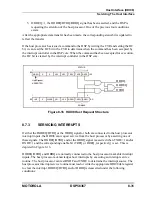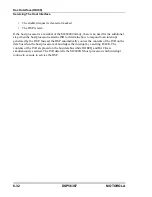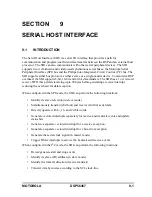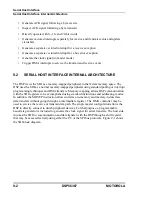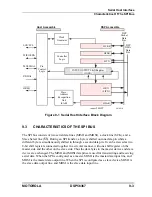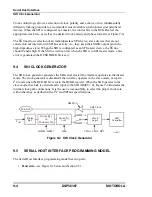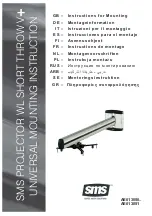
9-12
DSP56367
MOTOROLA
Serial Host Interface
Serial Host Interface Programming Model
9.5.5.4
HCKR Reserved Bits—Bits 23–14, 11
These bits in HCKR are reserved. They are read as zero and should be written with zero for
future compatibility.
9.5.5.5
HCKR Filter Mode (HFM[1:0]) — Bits 13–12
The read/write control bits HFM[1:0] specify the operational mode of the noise reduction
filters, as described in Table 9-3. The filters are designed to eliminate undesired spikes that
might occur on the clock and data-in lines and allow the SHI to operate in noisy environments
when required. One filter is located in the input path of the SCK/SCL line and the other is
located in the input path of the data line (i.e., the SDA line when in I
2
C mode, the MISO line
when in SPI master mode, and the MOSI line when in SPI slave mode).
When HFM[1:0] = 00, the filter is bypassed (spikes are not filtered out). This mode is useful
when higher bit-rate transfers are required and the SHI operates in a noise-free environment.
When HFM[1:0] = 10, the narrow-spike-tolerance filter mode is selected. In this mode the
filters eliminate spikes with durations of up to 50ns. This mode is suitable for use in mildly
noisy environments and imposes some limitations on the maximum achievable bit-rate
transfer.
When HFM[1:0] = 11, the wide-spike-tolerance filter mode is selected. In this mode the filters
eliminate spikes up to 100 ns. This mode is recommended for use in noisy environments; the
bit-rate transfer is strictly limited. The wide-spike- tolerance filter mode is highly
recommended for use in I
2
C bus systems as it fully conforms to the I
2
C bus specification and
improves noise immunity.
Note:
HFM[1:0] are cleared during hardware reset and software reset.
After changing the filter bits in the HCKR to a non-bypass mode (HFM[1:0] not equal to
‘00’), the programmer should wait at least ten times the tolerable spike width before enabling
the SHI (setting the HEN bit in the HCSR). Similarly, after changing the HI
2
C bit in the
HCSR or the CPOL bit in the HCKR, while the filter mode bits are in a non-bypass mode
(HFM[1:0] not equal to ‘00’), the programmer should wait at least ten times the tolerable
spike width before enabling the SHI (setting HEN in the HCSR).
Table 9-3 SHI Noise Reduction Filter Mode
HFM1
HFM0
Description
0
0
Bypassed (Disabled)
0
1
Reserved
1
0
Narrow Spike Tolerance
1
1
Wide Spike Tolerance
Summary of Contents for DSP56367
Page 16: ...xvi MOTOROLA CONTENTS Paragraph Number Title Page Number ...
Page 22: ...xxii MOTOROLA List of Figures Figure Number Title Page Number ...
Page 26: ...xxvi MOTOROLA List of Tables Table Number Title Page Number ...
Page 148: ...4 6 DSP56367 MOTOROLA Design Considerations PLL Performance Issues ...
Page 248: ...9 30 DSP56367 MOTOROLA Serial Host Interface SHI Programming Considerations ...
Page 306: ...10 58 DSP56367 MOTOROLA Enhanced Serial Audio Interface ESAI ESAI Initialization Examples ...
Page 389: ...Bootstrap ROM Contents MOTOROLA DSP56367 A 15 end ...
Page 390: ...A 16 DSP56367 MOTOROLA Bootstrap ROM Contents ...
Page 432: ...C 8 DSP56367 MOTOROLA JTAG BSDL ...
Page 484: ...D 52 DSP56367 MOTOROLA Programmer s Reference ...
Page 490: ...E 6 DSP56367 MOTOROLA Power Consumption Benchmark ...
Page 516: ...F 26 DSP56367 MOTOROLA IBIS Model ...
Page 522: ...Index 6 MOTOROLA Index ...
Page 523: ......


